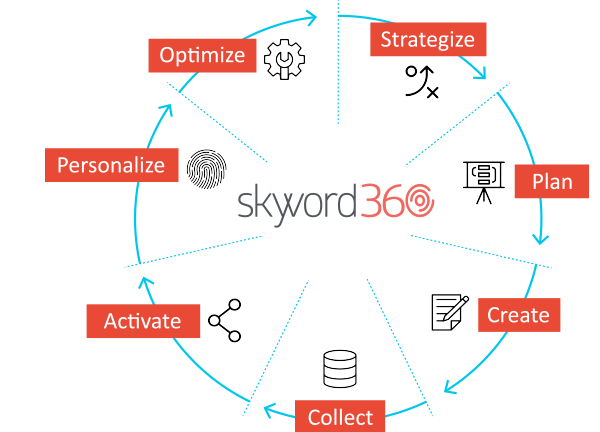For Google News
Too Many Marketing Tools? A Formula for Simplifying Your Martech Stack
By Kyle Harper on August 15, 2018
One of my favorite aspects of working on a marketing team is the "Christmas in July" feeling of getting new toys to play with. It happens all year round: new tech, new apps, a web tool here, a fresh new plugin there. However, that initial excitement of exploring all these new software and management tools often ends in frustration.
I might have 30 tools for 30 occasions, but I only really understand how to use a handful to their fullest potential. Simple tasks like keeping username and password information managed can become messy, quickly. Worst of all, even after we setup all these tools, we still run into technological mismatch with internal departments and stakeholders. Yet, we just keep renewing each subscription year after year.
It's no wonder that many marketing teams have reached the point of tech-overload. We've seen enormous growth in the martech sector each year since 2011, with a 40 percent increase in the number of unique tech providers from 2016 to 2017 alone. Combine this myriad of options with the widely diverse set of challenges and tasks that marketers tackle in their day-to-day, and you have a recipe for an overbuilt martech stack.
Recognizing your team has a tech problem can be a challenge in and of itself, and the idea of taking time out of your schedule to conduct an audit might seem like an enormous drain. But with a plan of attack and an eye towards lean effectiveness, a tech stack audit can be a powerful way to revitalize your team's workflow and eventually determine what marketing technologies will best meet all of your needs across your entire enterprise. Here's how to make the most of all your martech has to offer.
Image attribution: Alex Kotliarskyi
Recognizing the Problem
"There's an abundance of choice today in the martech tool world," explains Tracy Odell, a marketing tech expert who recently completed a massive audit for Student Loan Hero. "With so many great tools, it can be tempting to want to overbuild your tech stack so you can try them all."
Here are four simple tests you can use to judge if your tech stack is overbuilt:
1. Disuse: Do you have any tools that you or your team haven't used in the past six months?
2. Mismatch: Do you have any tools that you use only because it was preferred for collaboration with another team, department, or vendor?
3. Redundancy: Do you have any pairs or sets of tools that are being used to accomplish the same tasks that you could consolidate?
4. Expertise Creep: Does your tech mix require team members to master inordinate numbers of tools? A healthy rule of thumb from Tracy: "I don't think it's realistic to ask someone to become an expert at more than three or four tools."
If you find that two or more of these tests are true for your organization, it might be time to examine your tech stack. The problem to focus on here isn't just how many tools you're using, but the effect it has on your marketing team. Too many tools can quickly result in distraction and confusion that will quietly decay your team's efficiency over time. Thankfully, you can prevent this from happening with a smartly-timed audit.
Consolidating Your Tech Stack
Understanding your team and their needs is the hardest leg work to do when starting this process, but once you have everyone in your organization on the same page, audits will become an easier matter. As Tracy explains it, "The first audit is the hardest and will take the longest because you'll need to set up requirements and process and get everyone on board."
From gathering your stakeholders to cutting the chaff, here is a framework to guide your next (possibly first) marketing tools audit.
Gather Stakeholders, Assign Owners, Listen
There are three primary groups that you'll interact with during your audit.
The first, largest, and most obvious group is the end users. These are the people from your team who have the most insight into how your tech is currently being used and why people prefer certain tools over others. Early on in this process, you'll want to gather impressions and insights from this group in aggregate. Thankfully, this doesn't have to be a hugely involved process.
As Tracy suggests, "A simple online survey can be really effective to collect front line feedback to understand how the tools are being used and how people feel about them."
Your second group is the stakeholders. This is a narrower group than your end-users, and tends to be a mix of strategic players and management for your team. These are the folks who understand what your department needs to be achieving at a high level, and can effectively distill requirements that will keep your teams effective. "I like to start with listening sessions and hear from all the stakeholders then take that feedback and divide it into "needs" versus "wants," Tracy explains.
The last group to keep in mind is your tool owners. Ideally, you should be able to assign an owner to each of your tools who has a high level of expertise with that tool. This not only ensures that you're getting the best information about how your team uses a tool currently, but also sets up a framework for better using whatever tools remain after your audit is completed. This group will be key for identifying redundancies and efficiencies as you sort through old tools and new tools.
Define ROI
Image attribution: Kaleidico
With input from your three groups, it's now important to define what ROI looks like for each tool that you evaluate. Can you quantify how much value it generates for your company and compare it to cost? Is there a key efficiency it affords your team that you would be in a poor position without? One method Tracy uses is to think about why you acquired a tool in the first place. Was it to save money, time, or effort? Has the tool actually accomplished that initial goal for your team?
With these measures in mind, try to begin sorting your tools into bins based on what they do for your team and how effectively they've been accomplishing that work. You should quickly start to see some overlap and softness in your stack that could benefit from repurposing or trimming. As you work through each of the task verticals and trim down to focus on a smaller number of tools, keep an eye on ROI (don't sacrifice efficiency for the sake of fewer tools) and who ownership belongs to (tool ownership after your audit will help keep your stack healthy and updated over time).
Consolidate and Calculate
At this point, you should have the information in hand necessary to begin consolidating your stack and identifying spaces where perhaps new tools could do the work of two or three. Tracy recommends trying to identify "centerpiece" tools that can accomplish three or more of the tasks that are important to your team and leaning into them. Often, these tools get overlooked for simple reasons like adoption order. For instance, why would I use my email browser's calendaring system if we already had a different scheduling tool in place?
This is why the most effective tools for marketers are those that tackle all stages of the content marketing process from strategizing, ideation, content creation, and optimization across multiple channels. Skyword's newly redesigned content marketing software, Skyword360, fulfills all of these needs through a platform that delivers end-to-end management and execution of content strategy across the entire enterprise.
Seeking out a technology option that fulfills the needs of multiple areas of your operation and can be integrated to serve cross-functional teams is one of the biggest steps forward you can take when looking to more efficiently meet your business goals.
Finally, a seemingly easy step but one that can be overlooked: Make sure you've stopped paying for your old tools once you're done! "When I did a recent audit, I asked our finance team to send me a list of recurring charges on our corporate credit card," Tracy recounts. "Through that exercise, we identified some tools that we were still paying for, but weren't being used anymore."
A More Efficient Future
The advantages of conducting a tech audit are huge. It allows you to potentially save your company money while also consolidating your team's efforts into a more centralized space to improve performance. Beyond this, the research and gathering stages of an audit can help you recenter yourself around your team's work. You might learn about tasks going on that you weren't aware of, or learn that a team's priorities have strayed a bit from your higher level strategy.
Get financially lean, get your mean number of tools under control, and learn a lot about your team in the process-this is what a marketing tech audit is all about.
To learn more about how cross-functional martech tools like Skyword360 helps manage all their content needs through a streamlined, enterprise, schedule a demo.
Featured image attribution: Domenico Loia



